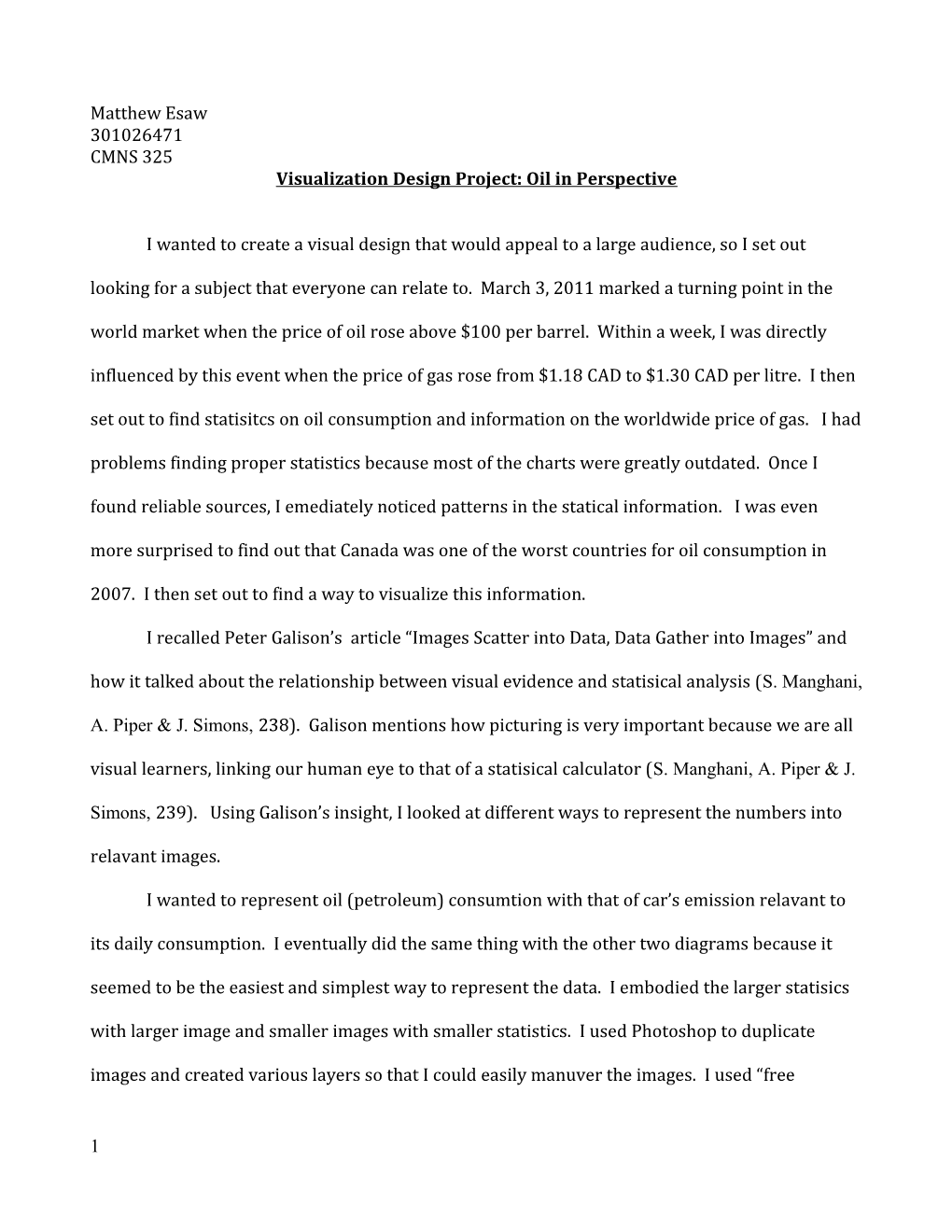Matthew Esaw
301026471
CMNS 325
Visualization Design Project: Oil in Perspective
I wanted to create a visual design that would appeal to a large audience, so I set out looking for a subject that everyone can relate to. March 3, 2011 marked a turning point in the world market when the price of oil rose above $100 per barrel. Within a week, I was directly influenced by this event when the price of gas rose from $1.18 CAD to $1.30 CAD per litre. I then set out to find statisitcs on oil consumption and information on the worldwide price of gas. I had problems finding proper statistics because most of the charts were greatly outdated. Once I found reliable sources, I emediately noticed patterns in the statical information. I was even more surprised to find out that Canada was one of the worst countries for oil consumption in 2007. I then set out to find a way to visualize this information.
I recalled Peter Galison’s article “Images Scatter into Data, Data Gather into Images” and how it talked about the relationship between visual evidence and statisical analysis (S. Manghani, A. Piper & J. Simons, 238). Galison mentions how picturing is very important because we are all visual learners, linking our human eye to that of a statisical calculator (S. Manghani, A. Piper & J. Simons, 239). Using Galison’s insight, I looked at different ways to represent the numbers into relavant images.
I wanted to represent oil (petroleum) consumtion with that of car’s emission relavant to its daily consumption. I eventually did the same thing with the other two diagrams because it seemed to be the easiest and simplest way to represent the data. I embodied the larger statisicswith larger image and smaller images with smaller statistics. I used Photoshop to duplicate images and created various layers so that I could easily manuver the images. I used “free transform” to scale the images to proportion, and the text tool to add in the statisics under each image.
Edward Tufte talks about how to improve a visual designs in his article “The Fundamental principles of Analytical Design”. Tufte uses various principles as a checklist of how visual statistical designs should look. He puts emphasis on making the design as simple as possible. After reviewing Tufte’s article, I implemented his 6 Principles to improve my design. Tufte’s first principle talks about showing comparison and contrast. For each of my diagrams I made sure that comparisons and contrasts were easily seen with visual representationsthat relates to statistical information. The3 diagrams also compares different relationships between oil and the world. Tufte’s second principle looks at showing casuality, mechanism and explaination of the structure. By putting the visual designs in their perspectice scales based on their statistical information I hoped to achieve causality and suffecient explaination of the diagrams. There is always one overwellming statistic that overshadows the rest of the information, so I used the largest statistic as a refrence point for scaling the other images in each design. The third principle indicates multivariate analysis or the use of more than 2 variables. I believe I achieved this by using many different types of visual and statistical representations within the diagrams. For instance, looking at the “Oil Consumption by Country” diagram, I used the US emission cloud as another variable by fitting 5 other country’s emisson clouds within it, which adds another aspect to the design. Tufte’s fourth principles deals with integrating numbers in relation to the design, which I believe I did. I achieved Tufte’s fifth principle of documenation the design by placing sources of the statisics at the bottom of each diagram. Finally, the sixth principle deals with getting rid of unnessessary clutter or “chart junk” as an effort to simplify the desgin. Now, I believe my visualizationis clean, straight forward and ready for an audience!
Bibliography
Azerbaijan, B. & Badalova, T. A. (2009). “Petrol Prices: Euro-Super-95 in 27 EU countries (May 3-10)”. Allbusiness.com. Retrieved from:
Ebert, S., Metschies, G.P., Schmid, D.,& Wagner, A. (2009, December).International Fuel Prices. Eschborn: GTZ Transport Policy Advisory Services.
Sunil Manghani, Arthur Piper and Jon Simons (2006) Images: A Reader. SAGE Publications Ltd.
Tufte, Edwards (n.d)The Fundamental principles of Analytical Design
“Consumption (most recent) by Country.” (2008, December). Nationmaster.com. Retrieved from:
“Usage per Person (most recent) by Country.” (n.d.). Nationmaster.com. Retrieved from:
“World Gas Prices By Country.“ (2010). Global Gas Prices: Hybrid Sales. Retrieved from:
1
